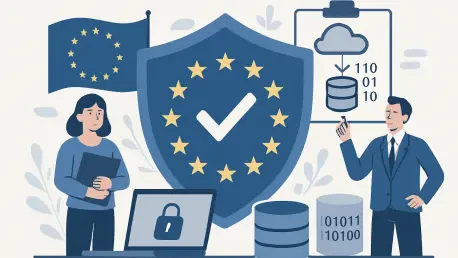I’m thrilled to sit down with Chloe Maraina, a renowned Business Intelligence expert with a deep passion for crafting compelling visual stories through big data analysis. With her extensive background in data science and a forward-thinking vision for data management and integration, Chloe is the perfect person to guide us through the complexities of the EU Data Act. Today, we’ll explore the essentials of this regulation, practical steps for compliance, and how businesses can turn these requirements into opportunities for growth and trust. Our conversation will touch on understanding the legislation, managing data inventories, ensuring fair contracts, and fostering a culture of compliance in a rapidly evolving digital landscape.
Can you give us a broad overview of the EU Data Act and explain why it’s such a significant piece of legislation for businesses in the EU?
Absolutely. The EU Data Act is a transformative regulation that’s part of the EU’s Digital Strategy, aimed at creating a single market for data across all sectors. Unlike GDPR, which focuses on personal data protection, this Act primarily deals with non-personal and industrial data, especially from connected devices like IoT systems. Its main goal is to unlock the economic value of data by setting clear rules on access, sharing, and portability. For businesses, especially in tech and digital sectors, it’s a game-changer because it dictates how data generated by their products and services can be used and shared, ensuring fairness and fostering innovation. It’s critical to pay attention because non-compliance can lead to legal risks, while embracing it can position a company as a trusted player in the digital economy.
Why is conducting a comprehensive data inventory such an important first step for compliance with the EU Data Act?
A data inventory is essentially the foundation of compliance. It’s about knowing exactly what data your business handles, where it comes from, and who has access to it. This means categorizing everything—personal, non-personal, machine-generated data—and mapping out its flow through your systems and connected devices. It’s crucial because the EU Data Act emphasizes transparency in access rights and portability, so you need a clear picture to align with those requirements. The challenge often lies in the sheer volume and complexity of data, especially with IoT devices that generate constant streams of information. Without this inventory, you’re flying blind and could miss critical gaps in compliance.
The EU Data Act places a strong emphasis on fairness in data-sharing agreements. Can you elaborate on why this matters so much to businesses?
Fairness in data-sharing agreements is a cornerstone of the EU Data Act because it aims to prevent data monopolies and level the playing field, especially in business-to-business and business-to-government interactions. Unfair terms can lock companies into exploitative arrangements or limit access to valuable data, stifling competition. Businesses need to scrutinize their contracts with vendors and partners, ensuring clear rights and responsibilities, reasonable terms, and mechanisms for resolving disputes. If you’re stuck with outdated or one-sided agreements, you risk enforcement actions or even having those terms voided, which can disrupt operations and damage relationships.
Data portability and interoperability are key components of the EU Data Act. How can businesses approach these requirements effectively?
Data portability and interoperability under the EU Data Act mean that users—whether individuals or businesses—should be able to access and transfer data from connected devices to other services seamlessly. For businesses, this requires designing systems with secure data export capabilities, like offering standardized APIs or accessible download formats. It’s not just about compliance; interoperability can enhance collaboration and build customer trust by making data sharing smoother. The technical hurdles, though, can be significant—think legacy systems or incompatible formats. The key is to invest early in adaptable infrastructure and test these processes to avoid hiccups when users request data transfers.
How important is it to train employees and build a culture of compliance when it comes to the EU Data Act, and what should that training focus on?
Training and culture are absolutely vital. Compliance isn’t just a policy on paper—it’s executed through people. Every employee, from IT to customer service, needs to understand their role in data governance under the EU Data Act. Training should cover the types of data the company handles, who owns it, the rights users have under the Act, and how to handle access or portability requests. Building that culture means ensuring everyone feels accountable, which can be reinforced through regular updates to privacy policies and open communication. Without this, even the best systems can fail due to human error or lack of awareness.
The EU Data Act allows public bodies to access private data in emergencies. What steps should businesses take to be ready for such scenarios?
Preparing for emergency data requests is about having a clear, actionable plan. The EU Data Act permits public bodies to access private data during crises like pandemics or natural disasters, so businesses need to designate a specific point of contact for these requests. You should also establish internal processes to verify the legitimacy and urgency of a request and ensure data can be delivered securely and quickly. It’s rare, but having a documented protocol prevents chaos and ensures you’re responding legally and efficiently when the situation arises.
What is your forecast for the future of data regulation in the EU, especially with laws like the Data Act continuing to evolve?
I believe we’re just at the beginning of a major shift in how data is regulated in the EU. The Data Act is a clear signal that the focus is expanding beyond personal data to encompass industrial and non-personal data, with an emphasis on fairness and accessibility. As implementation guidance and enforcement practices develop, I expect more detailed frameworks and possibly stricter penalties to emerge, pushing businesses to prioritize data transparency. We’ll likely see tighter integration with other regulations like GDPR, creating a more cohesive digital ecosystem. My forecast is that companies who adapt proactively—viewing compliance as a strategic advantage—will lead the pack, while those who lag behind will face increasing pressure from regulators and competitors alike.









